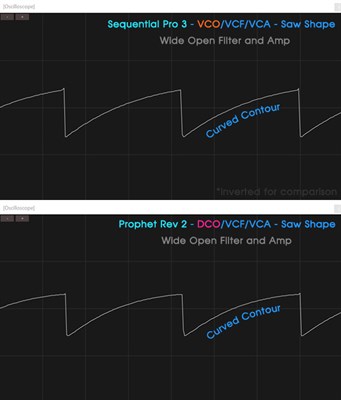Synth Oscillator Wave Shape Variance
Exploring the reasons for synths having different core wave shapes
 If you compare several different vintage and modern synths, as well as comparing VCO vs DCO vs Digital Oscillators, you may notice that Core Oscillator Waveshape varies from synth to synth. Sometimes the variance is more subtle, but sometimes it can be more drastic. The net effect on the waveshape variance can subtly affect the harmonic series of the output and the noise level.
If you compare several different vintage and modern synths, as well as comparing VCO vs DCO vs Digital Oscillators, you may notice that Core Oscillator Waveshape varies from synth to synth. Sometimes the variance is more subtle, but sometimes it can be more drastic. The net effect on the waveshape variance can subtly affect the harmonic series of the output and the noise level.
On many classic synths, if you open the VCF filter wide open and amp, and analyze a square or sawtooth, you may notice a curved contour or angular leaning to the straight sections of the wave shape. Conversely, if you take a digital synth and output a pure saw or square wave, you'll see very straight contours.
On some older/vintage synths, manufacturers implemented a sort of high pass filter, under the fundamental to reduce excess noise and unwanted artifacts. The net effect of applying a HP filter, an octave or two under the fundamental, is that it results in these shaped contours of the core wave shapes.
Comparing Voltage Controlled Oscillator (VCO) vs Digitally Controlled Analog Oscillator (DCO)
 There is often a misconception about the sound characteristics of DCO oscillators. Many people claim that the raw sound of the oscillators is not as good as a VCO oscillator. The truth is they are both analog where it counts, in the wave shaping circuitry.
There is often a misconception about the sound characteristics of DCO oscillators. Many people claim that the raw sound of the oscillators is not as good as a VCO oscillator. The truth is they are both analog where it counts, in the wave shaping circuitry.
The big difference comes in their tuning accuracy. VCOs are inherently harder to tame, and usually have frequency offsets from their nominal targets, when measures over several octave ranges. This intonation tuning behavior and variance between the nominal tuning of oscillators on each voice board leads to a large majority of the "vintage VCO poly synth character" that is so desired. Click here for more info on Per Voice Variance and Voice Modeling.
DCOs, on the other hand have digitally controlled frequency clocks that lock the output frequency to the nominal value for a given key, rendering them to be always in tune over extended octave ranges. In addition, VCOs do exhibit some harmonic jitter / phase jitter, which is a relatively high frequency, but low amount of jitter in their nominal frequency, and harmonic series.
Click here for more info on VCO Harmonic Jitter
From a Core Wave Shape perspective, however, DCOs and VCOs can render identical analog waveshapes with all the peculiarities of wave contour and harmonic series, given appropriate circuit designs. To the right, you can see a comparison of a VCO>VCF>VCA sawtooth with a DCO>VCF>VCA saw. As you can see, they are basically identical in their core waveshape, and in turn, their harmonic series that is output.
Highpass Filter under Fundamental Effect
Here is an example of a custom digital synth (PolyMage Reaktor) that demonstrates the effect of introducing a Highpass Filter underneath the fundamental. In the first example, there is no Highpass Filter applied, and you see the perfect square wave output. In the second example, a Highpass filter has been applied two octaves underneath the fundamental, resulting in a moderate curved/angled contour that you might encounter in a variety of VCO and DCO synths from the past several decades. In the final example, a highpass filter is applied just one octave underneath the fundamental, resulting in dramatic curves/contours to the core square wave shape. In some vintage VCO synths you may encounter wave shapes similar to this.
